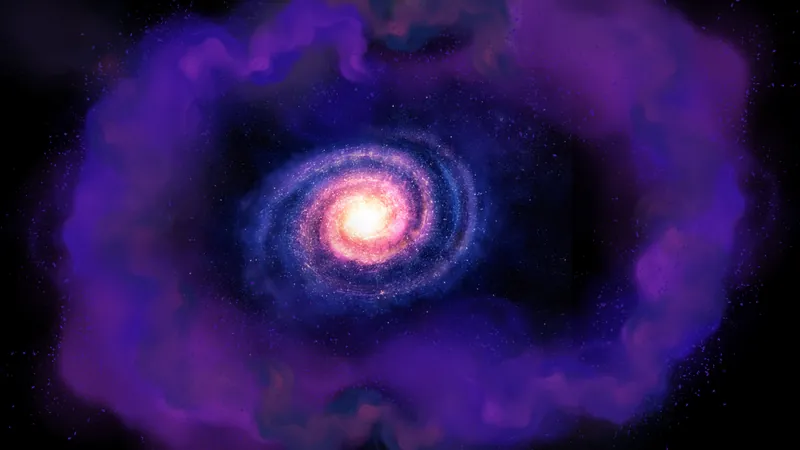
Shocking Discovery: Dark Matter Might Be Responsible for Mysterious Break in Stellar Stream!
2025-01-14
Author: Wei Ling
Groundbreaking Discovery about the GD-1 Stellar Stream
A groundbreaking new study suggests that a puzzling 'break' in the GD-1 stellar stream—an elongated group of stars tracing a path through the Milky Way—may be linked to self-interacting dark matter. This finding has the potential to reshape our understanding of dark matter and the cosmos.
The Enigma of the GD-1 Stellar Stream
The GD-1 stellar stream has fascinated astronomers for years due to its peculiar structure, characterized by a noticeable gap that has remained unexplained—until now. Researchers from the University of California, Riverside, led by professor Hai-Bo Yu, have posited that a sub-halo of dark matter, which interacts with itself, could be responsible for this enigmatic feature. 'This work opens a promising new avenue for investigating the self-interacting properties of dark matter through stellar streams,' Yu stated.
Understanding Dark Matter
Dark matter, a mysterious substance that makes up about 85% of the universe, is not composed of conventional atoms and does not emit light. This has rendered it largely invisible to traditional observational methods. Scientists have long debated whether dark matter interacts with itself, a question that has baffled physicists globally.
Gravity: The Invisible Influence
The mystery deepens because, while dark matter does not interact with ordinary matter, its gravitational effects are undeniable. This phenomenon is akin to using a shadow as evidence of an unseen object: while you can’t see dark matter directly, its influence can be captured through the movement of stars and galaxies.
Explaining the GD-1 Stellar Stream's Gap
In the case of the GD-1 stellar stream, researchers found that the gravitational pull from known celestial objects—the globular clusters and satellite galaxies currently known to the Milky Way—could not explain the peculiar disruption observed in the stream. This leads to the tantalizing conclusion that undetected, dense patches of dark matter could create gravitational disturbances that affect how stars in the stream move.
Implications for Dark Matter Models
For this theory to hold, researchers believe that the dark matter sub-halo must be denser than what current models predict, particularly the Lambda Cold Dark Matter (LCDM) model, which describes the undiscovered substance as slow-moving and non-interacting. However, if self-interacting dark matter does exist—and is capable of collapsing under its own gravitational influence—the drive toward denser formations becomes feasible.
Simulation Results
Yu and his team simulated the effects of such a collapsing dark matter sub-halo on the GD-1 stream and found that it could reproduce the observed features of the stellar gap. In this new model, the 'perturber' responsible for the gaps in the stream is not a massive star or celestial body, but rather this mysterious self-interacting dark matter.
A New Era in Dark Matter Research
This revolutionary finding suggests that our current understanding of dark matter might be fundamentally flawed, opening up avenues for future research that could redefine cosmology. Imagine discovering that dark matter plays a more dynamic role in the fabric of the universe than previously understood!
Conclusion: The Quest for Knowledge Continues
As scientists continue to explore the mysteries surrounding dark matter, this research provides a tantalizing glimpse into an even more complex universe. The possibilities this discovery unlocks may soon lead to monumental shifts in how we comprehend not only dark matter but the very structure of the cosmos itself. Keep watching the stars, for they may hold the keys to unlocking our universe’s deepest secrets!


 Brasil (PT)
Brasil (PT)
 Canada (EN)
Canada (EN)
 Chile (ES)
Chile (ES)
 Česko (CS)
Česko (CS)
 대한민국 (KO)
대한민국 (KO)
 España (ES)
España (ES)
 France (FR)
France (FR)
 Hong Kong (EN)
Hong Kong (EN)
 Italia (IT)
Italia (IT)
 日本 (JA)
日本 (JA)
 Magyarország (HU)
Magyarország (HU)
 Norge (NO)
Norge (NO)
 Polska (PL)
Polska (PL)
 Schweiz (DE)
Schweiz (DE)
 Singapore (EN)
Singapore (EN)
 Sverige (SV)
Sverige (SV)
 Suomi (FI)
Suomi (FI)
 Türkiye (TR)
Türkiye (TR)
 الإمارات العربية المتحدة (AR)
الإمارات العربية المتحدة (AR)